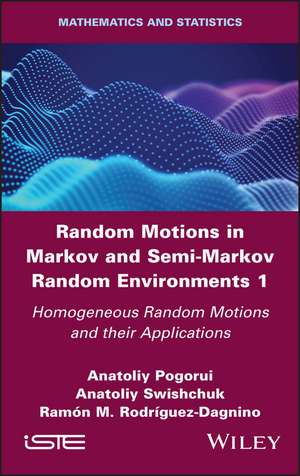Random Motions in Markov and Semi–Markov Random Environments 1 – Homogeneous Random Motions and their Applications
Autor Pogoruien Limba Engleză Hardback – 4 mar 2021
Preț: 981.19 lei
Preț vechi: 1078.23 lei
-9% Nou
Puncte Express: 1472
Preț estimativ în valută:
187.81€ • 204.07$ • 157.86£
187.81€ • 204.07$ • 157.86£
Carte tipărită la comandă
Livrare economică 21 aprilie-05 mai
Preluare comenzi: 021 569.72.76
Specificații
ISBN-13: 9781786305473
ISBN-10: 178630547X
Pagini: 256
Dimensiuni: 159 x 243 x 19 mm
Greutate: 0.53 kg
Editura: ISTE Ltd.
Locul publicării:Hoboken, United States
ISBN-10: 178630547X
Pagini: 256
Dimensiuni: 159 x 243 x 19 mm
Greutate: 0.53 kg
Editura: ISTE Ltd.
Locul publicării:Hoboken, United States
Cuprins
Preface ix
Acknowledgments xiii
Introduction xv
Part 1. Basic Methods 1
Chapter 1. Preliminary Concepts 3
1.1. Introduction to random evolutions 3
1.2. Abstract potential operators 7
1.3. Markov processes: operator semigroups 11
1.4. Semi-Markov processes 14
1.5. Lumped Markov chains 17
1.6. Switched processes in Markov and semi-Markov media 19
Chapter 2. Homogeneous Random Evolutions (HRE) and their Applications 23
2.1. Homogeneous random evolutions (HRE) 24
2.1.1. Definition and classification of HRE 24
2.1.2. Some examples of HRE 25
2.1.3. Martingale characterization of HRE 28
2.1.4. Analogue of Dynkin's formula for HRE 34
2.1.5. Boundary value problems for HRE 36
2.2. Limit theorems for HRE 37
2.2.1. Weak convergence of HRE 37
2.2.2. Averaging of HRE 39
2.2.3. Diffusion approximation of HRE 42
2.2.4. Averaging of REs in reducible phase space: merged HRE 45
2.2.5. Diffusion approximation of HRE in reducible phase space 48
2.2.6. Normal deviations of HRE 51
2.2.7. Rates of convergence in the limit theorems for HRE 53
Part 2. Applications to Reliability, Random Motions, and Telegraph Processes 57
Chapter 3. Asymptotic Analysis for Distributions of Markov, Semi-Markov and Random Evolutions 59
3.1. Asymptotic distribution of time to reach a level that is infinitely increasing by a family of semi-Markov processes on the set N 61
3.2. Asymptotic inequalities for the distribution of the occupation time of a semi-Markov process in an increasing set of states 74
3.3. Asymptotic analysis of the occupation time distribution of an embedded semi-Markov process (with increasing states) in a diffusion process 77
3.4. Asymptotic analysis of a semigroup of operators of the singularly perturbed random evolution in semi-Markov media 82
3.5. Asymptotic expansion for distribution of random motion in Markov media under the Kac condition 90
3.5.1. The equation for the probability density of the particle position performing a random walk in R^n 90
3.5.2. Equation for the probability density of the particle position 91
3.5.3. Reduction of a singularly perturbed evolution equation to a regularly perturbed equation 93
3.6. Asymptotic estimation for application of the telegraph process as an alternative to the diffusion process in the Black-Scholes formula 96
3.6.1. Asymptotic expansion for the singularly perturbed random evolution in Markov media in case of disbalance 96
3.6.2. Application to an economic model of stock market 100
Chapter 4. Random Switched Processes with Delay in Reflecting Boundaries 103
4.1. Stationary distribution of evolutionary switched processes in a Markov environment with delay in reflecting boundaries 104
4.2. Stationary distribution of switched process in semi-Markov media with delay in reflecting barriers 109
4.2.1. Infinitesimal operator of random evolution with semi-Markov switching 110
4.2.2. Stationary distribution of random evolution in semi-Markov media with delaying boundaries in balance case 113
4.2.3. Stationary distribution of random evolution in semi-Markov media with delaying boundaries 121
4.3. Stationary efficiency of a system with two unreliable subsystems in cascade and one buffer: the Markov case 124
4.3.1. Introduction 124
4.3.2. Stationary distribution of Markov stochastic evolutions 125
4.3.3. Stationary efficiency of a system with two unreliable subsystems in cascade and one buffer 129
4.3.4. Mathematical model 131
4.3.5. Main mathematical results 133
4.3.6. Numerical results for the symmetric case 138
4.4. Application of random evolutions with delaying barriers to modelling control of supply systems with feedback: the semi-Markov switching process 141
4.4.1. Estimation of stationary efficiency of one-phase system with a reservoir 141
4.4.2. Estimation of stationary efficiency of a production system with two unreliable supply lines 149
Chapter 5. One-dimensional Random Motions in Markov and Semi-Markov Media 159
5.1. One-dimensional semi-Markov evolutions with general Erlang sojourn times 160
5.1.1. Mathematical model 160
5.1.2. Solution of PDEs with constant coefficients and derivability of functions ranged in commutative algebras 168
5.1.3. Infinite-dimensional case 171
5.1.4. The distribution of one-dimensional random evolutions in Erlang media 172
5.2. Distribution of limiting position of fading evolution 181
5.2.1. Distribution of random power series in cases of uniform and Erlang distributions 182
5.2.2. The distribution of the limiting position 190
5.3. Differential and integral equations for jump random motions 191
5.3.1. The Erlang jump telegraph process on a line 192
5.3.2. Examples 198
5.4. Estimation of the number of level crossings by the telegraph process 199
5.4.1. Estimation of the number of level crossings for the telegraph process in Kac's condition 202
References 205
Index 219
Summary of Volume 2 221
